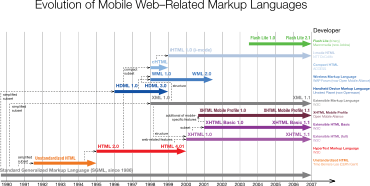Handheld Device Markup Language

Evolution of mobile web standards
The Handheld Device Markup Language (HDML) is a markup language [1] intended for display on handheld computers, information appliances, smartphones, etc.. It is similar to HTML,[2] but for wireless and handheld devices with small displays, like PDA, mobile phones and so on.
It was originally developed in about 1996 by Unwired Planet,[3] the company that became Phone.com and then Openwave.[4] HDML was submitted to W3C for standardization,[5] but was not turned into a standard. Instead it became an important influence on the development and standardization of WML, which then replaced HDML in practice. Unlike WML, HDML has no spupport for scripts.[6]
See also
References
- ↑ "HDML Language Specification". 1997-04-11.
- ↑ Blass, Steve (October 11, 1999). "Ask Dr. Intranet What does HDML stand for and what is its purpose?". Network World. Vol. 16 no. 41. IDG. p. 41. ISSN 0887-7661.
- ↑ "AllianceRoundup, Redwood Shores, Calif". InfoWorld. Vol. 18 no. 41. IDG. October 7, 1996. p. TW/1. ISSN 0199-6649.
- ↑ Dragan, Richard V. (March 6, 2001). "Internet Pro, Wireless by Design". PC Magazine. Vol. 20 no. 5. Ziff Davis. p. IP04. ISSN 0888-8507.
- ↑ "HDML Standard Submission & Specification". 1997-04-11.
- ↑ Pender, Danielle; Dunne, Lee (March 15, 2001). "Glossary, HDML". CIO. Vol. 14 no. 11. CXO Media (IDG). p. 126. ISSN 0894-9301.
External links
This article is issued from
Wikipedia.
The text is licensed under Creative Commons - Attribution - Sharealike.
Additional terms may apply for the media files.